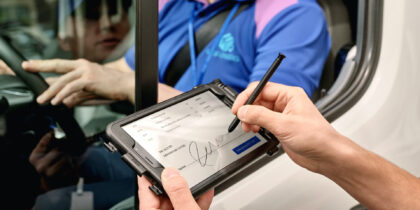If you operate a trucking fleet, you already know: competition is fierce. And it’s only going to get worse as demand for fleet services increases and the driver shortage deepens. The American Trucking Associations estimate the industry was short more than 60,000 drivers at the end of last year. Meanwhile, demand for freight services will continue to grow — by over 2 percent per year through 2024, according to Reuters.
Operating expenses are also increasing. The average cost per mile to operate a truck was $1.69 in 2017, according to the American Transportation Research Institute — an increase of 6 percent from the previous year. While the cost of diesel has remained fairly steady over the past couple years at about $3.10 per gallon, labor costs have been increasing, as fleets offer more money to retain the drivers they have and recruit new talent.
Fleets That Capitalize on Mobile Technology Pull Ahead
With the industry so constrained, the fleets that do best are the ones that offer the most value — providing the most efficient and effective service at the best price. Trucking industry database TruckInfo.net estimates 1.2 million trucking companies operate in the United States, so customers have a lot of options when it comes to getting their goods where they need to be — on time and for a competitive price. The last thing they want is for transportation costs to cut into their bottom line.
Increase Fleet Efficiencies With In-Cab Technology
Learn how ELD implemented on mobile platforms reduces operating costs and improves driver retention. Download Now
Increasingly, technology is the differentiator. Advanced mobile solutions that use smartphones or tablets are a triple win for fleets, helping to streamline operations, improve life on the road for drivers and improve transparency for fleet customers. As valuable as mobile technology is for fleet operators to automate hours of service (HOS) tracking and maintenance — which has the added benefit of simplifying routine tasks for drivers — it also provides fleet customers with a higher level of transparency for their goods’ movement. With mobile fleet technology, they can see where a vehicle is located at any given time, as well as real-time road conditions that may affect delivery times — and increase costs.
Automated Solutions Create a New Road Map of Efficiencies
Automating log books with mobile solutions also saves money because it’s more efficient and accurate. There are various software solutions that can help. GPS truck navigation helps drivers find their best routes depending on the type of vehicle they’re driving, allowing them to add or remove stops and navigate HAZMAT roads in a safe manner. Using the same device, drivers can easily toggle to an HOS app to electronically log their hours and file driver vehicle inspection reports automatically.
Familiar Technology Speaks to Younger Drivers
Easy-to-use software on devices that operate like a personal smartphone or tablet is becoming critical for the recruitment and retention of younger drivers in particular. For the trucking industry’s growing population of millennial drivers who have grown up using such technology, mobile solutions aren’t just preferred — they’re expected. So fleets that employ younger drivers, and who want them to stay with their companies, will have an edge simply by incorporating smartphones or tablets into their operations.
Software can also simplify driver training. Instead of training new hires in person, which can take days and cost hundreds of dollars per driver, onboarding drivers with an online orientation can get them on the road faster and for less cost.
That’s important, especially for an industry that’s increasingly constrained by the availability of drivers. Driver turnover has been increasing over the past five years — and that turnover is costly, running carriers anywhere $2,243 to $20,729 per driver, according to the Upper Great Plains Transportation Institute.
Because fleets are only as good as their drivers, mobile technology can also keep an eye on drivers’ behavior, identifying problems before they become costly. Driver monitoring software can monitor drivers’ speeding, idling and fuel consumption and, above all, ensure they are operating safely — because few things are costlier than an unsafe driver.
Ultimately, the implementation of fleet technology can help reduce costs by improving efficiency. But it can also provide peace of mind, because mobile technology empowers all parts of the delivery chain — from fleet operator to driver to customer — with knowledge. And as they say, knowledge is power.
Read a case study to learn how an overhaul of in-cab technology improved fleet performance and profitability for Paper Transport, or get a free guide to raising efficiencies with mobile technology for your fleet.








